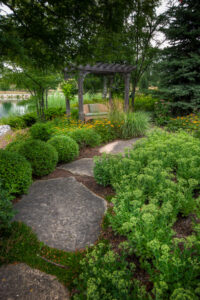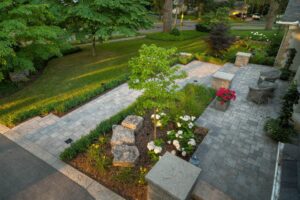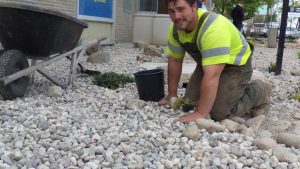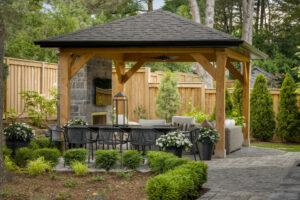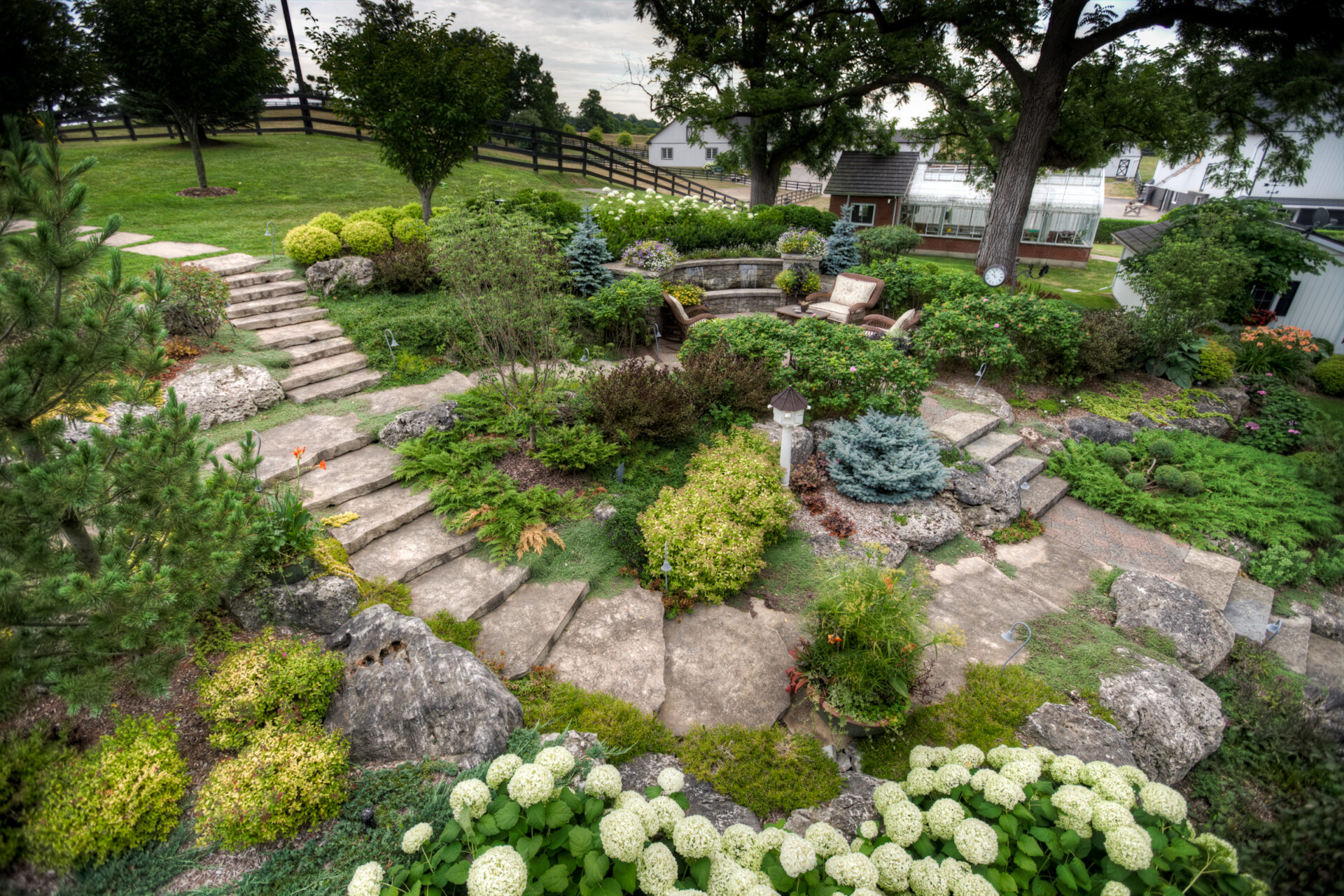
Landscaping in Southern Ontario can feel like a balancing act. Between sudden weather changes, different types of soil, and long winters, even the most motivated homeowners run into problems without a clear plan. Mistakes that seem small in the beginning often turn into bigger headaches over time, costing more effort and money to fix.
This guide gives you straightforward landscaping pro tips Ontario homeowners can trust. You’ll learn how to plan smarter, avoid common pitfalls and build an outdoor space that looks great, fits your life and grows stronger with every season.
Mistake #1: Ignoring the Local Climate
Southern Ontario weather has a personality of its own. Some summers bring prolonged heatwaves and dry spells, while winters often deliver heavy snow, freezing rain and biting winds. Landscapes that don’t account for these shifts usually struggle to stay healthy and attractive.
Pro Tip: Choose Plants Native to Southern Ontario
Using native plants is one of the smartest ways to build a low-maintenance garden. Black-eyed Susans, Eastern Redbuds, wild columbine and serviceberries are well-known choices that thrive in areas like Hamilton. They survive heat, frost and cold winds with less watering, fewer pest problems and no special treatments.
To keep your yard colourful year-round, you can mix early bloomers like serviceberries for spring, strong perennials like goldenrod for summer and ornamental grasses like little bluestem, which add texture and movement even through the winter. Native plants also support bees, butterflies and birds, helping your garden become part of the larger Southern Ontario ecosystem. The more your landscaping works with nature, the better results you’ll see with less effort.
Mistake #2: Skipping a Soil Test
Not all soil is created equal, especially across Southern Ontario. Some neighbourhoods sit on heavy clay soil that holds water for days after it rains. Other parts have sandy, loose soils where moisture drains away too quickly. Without knowing your soil type, choosing plants that will grow well is hard. It is also difficult to avoid issues like root rot or stunted growth.
Pro Tip: Know Your Soil Before You Plant
A basic soil test tells you the pH balance, nutrients and structure of your yard’s soil. Clay-heavy soils often need mixed compost to loosen them up and prevent puddling after rain. Sandy soils may require more organic matter to help them hold moisture and nutrients. You can find DIY soil test kits at local garden centres, or many Ontario labs offer full reports for a small fee. These detailed results can guide you in choosing plants and fertilizers and even show you how deep to mulch. Spending a little time on soil testing upfront saves a lot of headaches later and helps you build a stronger, healthier garden from the ground up.
Mistake #3: Watering the Wrong Way
Rainfall in Southern Ontario is unpredictable. A spring month might bring heavy storms, followed by a dry summer that bakes the ground. Without a smart watering system, it’s easy to swing between overwatering, which causes disease and root rot, and underwatering, which stresses plants to the point of no return.
Pro Tip: Install Smarter Watering Systems
Today’s smart irrigation systems monitor the weather and automatically adjust the amount of water your garden receives. These systems protect against common issues like root rot and heat stress during dry summers after a wet spring.
If a full smart system isn’t an option, drip irrigation lines combined with mulch are a game-changer. Drip irrigation puts water exactly where needed, at the roots, and reduces waste and evaporation. Mulching around plants also holds moisture in the soil, helps with temperature control and keeps weeds down. Setting your garden up with smart watering habits saves money on your water bill and keeps your plants healthier with less work.
Mistake #4: Planting Too Close Together
When you first plant a new garden, it can be tempting to crowd plants together to make the yard look instantly full and lush. But without giving plants room to grow, you’re setting up future problems.
Pro Tip: Space Plants for Their Future Size
A young shrub might look small today, but in two or three years, it could be taking over your walkway or blocking sunlight from your favourite flowers. Crowded plants fight for sunlight, water, and nutrients, leading to weaker growth and more diseases like powdery mildew. Good airflow is essential in humid summers to keep plants healthy. Spacing plants properly from the start helps prevent these issues naturally. It also saves you from extra pruning, costly transplanting, and later plant loss.
Planning with maturity in mind creates a more natural, beautiful and healthy landscape over time.
Mistake #5: Skipping Seasonal Care
Landscaping isn’t a one-and-done job. Every season in Southern Ontario brings new challenges, and missing key care tasks often leads to bigger problems down the road.
Pro Tip: Build a Simple Seasonal Maintenance Plan
Each season needs a little attention:
- Spring: Clean up fallen branches, prune damaged shrubs, refresh mulch and apply a slow-release fertilizer.
- Summer: Watch for signs of drought stress, pests and fungal diseases. Keep watering consistently.
- Fall: Reseed lawns, plant spring-flowering bulbs, protect trees with mulch collars and prepare beds for winter.
- Winter: Protect delicate shrubs with burlap wraps and gently remove heavy snow from branches after storms.
Cold snaps and ice buildup in Southern Ontario can damage young trees and shrubs. Small steps like tying tree trunks for support or using wind barriers can save you from expensive replacements come spring. Following a maintenance rhythm keeps your landscape vibrant, healthy, and much easier to manage year after year.
Mistake #6: Designing Only for Looks
A picture-perfect yard can feel empty if not designed for your lifestyle. Even the most beautiful spaces often go unused without places to sit, walk, or gather.
Pro Tip: Design for Everyday Life
Before planting or building anything, ask yourself what you want to do outside. Maybe you’d like a patio for morning coffee, a shaded path for evening walks or an open lawn where kids or pets can play. Great landscaping balances beauty and purpose. It uses pathways, seating areas and lighting naturally in the design so the space feels inviting and is not just something for you to admire from a distance.
In Southern cities like Hamilton, where outdoor living is valued, a well-planned yard becomes a natural piece of your home, offering comfort, relaxation and a real sense of pride in your property.
Mistake #7: Skipping Professional Help
Landscaping can be rewarding to do yourself, but bigger projects come with bigger risks. Grading mistakes, drainage problems and poor plant placement often don’t show up until it’s too late, and fixing them is much harder (and more expensive) than getting it right from the start.
Pro Tip: Bring in a Local Expert Early
Experienced landscaping professionals know the ins and outs of working in Southern Ontario’s climate. They can help you spot potential trouble early, recommend the right plants, plan proper drainage, and design a layout that fits your property and lifestyle. Hiring a professional might seem like a bigger upfront cost, but it usually saves money, time and frustration in the long run. It’s the easiest way to ensure your landscape looks beautiful and grows stronger every season.
Set Your Landscape Up for Success
Taking the time to avoid these common landscaping mistakes helps you create a yard that’s beautiful, easy to maintain, and ready to grow for years to come. With smart planning, tough native plants, good watering practices, and simple seasonal care, you can build a space that works with the Southern Ontario climate instead of fighting against it.
If you’d like more guidance on matching your landscaping goals with the right services, visit our blog: What Do Landscapers Do? A Guide to Landscaping Services in Southern Ontario. It offers practical advice and insights to help you choose the best path forward and create a space that feels right for you.
Ready to bring your landscape vision to life? Request an estimate from our team today and take the first step toward a yard that’s beautiful, practical and made to thrive in every season.

